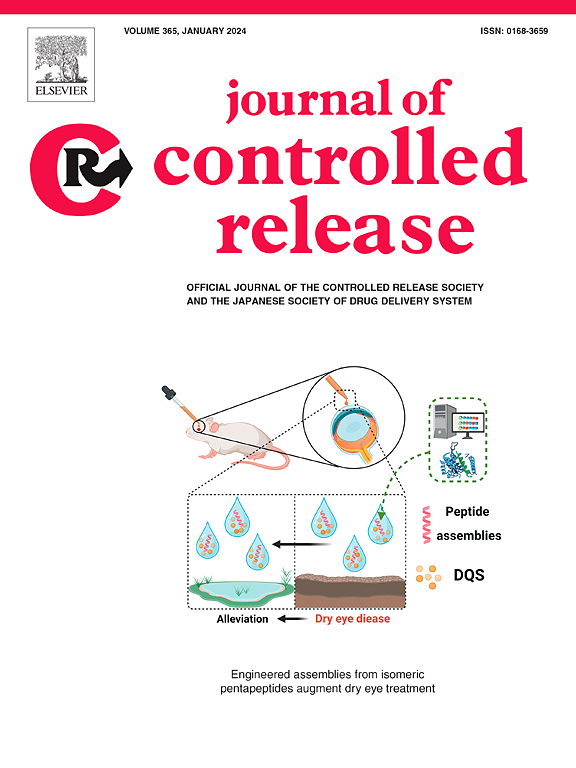Multifunctional delivery strategies and nanoplatforms of SN-38 in cancer therapeutics
IF 10.5
1区 医学
Q1 CHEMISTRY, MULTIDISCIPLINARY
引用次数: 0
Abstract
SN-38 or 7-ethyl-10-hydroxycamptothecin is the active metabolite of irinotecan, a widely used chemotherapeutic agent for the treatment of colorectal, pancreatic, lung, breast, gastric, esophageal, hepatocellular, ovarian, brain, leukemia, and lymphoma malignancies. SN-38's antitumoral effect is 100 to 1000 times more potent than that of irinotecan. However, its clinical application is hindered by its poor solubility and chemical instability. To circumvent these challenges and avoid systemic toxicities, such as myelosuppression and diarrhea, several SN-38 delivery systems have been explored. In that regard, formulations based on targeted, controlled and tumor-responsive release of SN-38 have demonstrated to enhance its antitumoral effects and reduce the associated systemic toxicities by limiting the pharmacological activity to the desired tumor location. To this end, prodrugs, conjugates, nanoparticles, dendrimers, or lipid-based strategies for SN-38 delivery have been used. Most recently, multifunctional approaches have emerged as an attractive alternative to develop SN-38 delivery systems, combining several strategies in a single formulation, i.e., encapsulating nanocarriers, tumor-targeting ligands, stimuli-responsive elements, optimal linkers, drug combinations or bioimaging agents. Despite their therapeutic advantages, multifunctional delivery systems often face challenges concerning their clinical translation compared to conventional therapies, such as biocompatibility, scalability and cost-effectiveness issues. The aim of this work is to review the most recent progress that has been made in the development and assessment of multifunctional delivery systems for cancer treatment.


SN-38在癌症治疗中的多功能递送策略和纳米平台
SN-38或7-乙基-10-羟基喜树碱是伊立替康的活性代谢物,伊立替康是一种广泛使用的化疗药物,用于治疗结肠、胰腺、肺、乳腺、胃、食管、肝细胞、卵巢、脑、白血病和淋巴瘤恶性肿瘤。SN-38的抗肿瘤效果是伊立替康的100到1000倍。但其溶解度差、化学稳定性不稳定,阻碍了其临床应用。为了规避这些挑战和避免全身毒性,如骨髓抑制和腹泻,已经探索了几种SN-38给药系统。在这方面,基于靶向、控制和肿瘤反应性释放SN-38的制剂已被证明可以增强其抗肿瘤作用,并通过将药理活性限制在所需的肿瘤部位来降低相关的全身毒性。为此,前体药物、缀合物、纳米颗粒、树状大分子或基于脂质的递送SN-38的策略已被使用。最近,多功能方法已成为开发SN-38递送系统的一种有吸引力的替代方法,将几种策略结合在单一配方中,即包封纳米载体,肿瘤靶向配体,刺激反应元件,最佳连接剂,药物组合或生物显像剂。尽管具有治疗优势,但与传统疗法相比,多功能输送系统在临床转化方面经常面临挑战,例如生物相容性、可扩展性和成本效益问题。这项工作的目的是回顾在癌症治疗多功能输送系统的开发和评估方面取得的最新进展。
本文章由计算机程序翻译,如有差异,请以英文原文为准。
求助全文
约1分钟内获得全文
求助全文
来源期刊

Journal of Controlled Release
医学-化学综合
CiteScore
18.50
自引率
5.60%
发文量
700
审稿时长
39 days
期刊介绍:
The Journal of Controlled Release (JCR) proudly serves as the Official Journal of the Controlled Release Society and the Japan Society of Drug Delivery System.
Dedicated to the broad field of delivery science and technology, JCR publishes high-quality research articles covering drug delivery systems and all facets of formulations. This includes the physicochemical and biological properties of drugs, design and characterization of dosage forms, release mechanisms, in vivo testing, and formulation research and development across pharmaceutical, diagnostic, agricultural, environmental, cosmetic, and food industries.
Priority is given to manuscripts that contribute to the fundamental understanding of principles or demonstrate the advantages of novel technologies in terms of safety and efficacy over current clinical standards. JCR strives to be a leading platform for advancements in delivery science and technology.
 求助内容:
求助内容: 应助结果提醒方式:
应助结果提醒方式:


